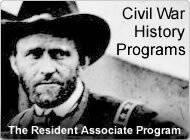
Book Review: Manhunt, by James L. Swanson
The Smithsonian Associates Civil War E-Mail Newsletter, Volume 8, Number 5
For many their view of history comes from those seemingly long days in school where the basic framework of important events is taught. One such historic event is Lincoln's assassination. Abraham Lincoln, along with his wife Mary, attended a production of Our American Cousin at Ford's Theatre in Washington City on the night of April 15, 1865. During the second act John Wilkes Booth entered the box where the Lincolns were seated and fired one shot. The following morning Lincoln died in the bedroom of a residence across the street from the theatre. Federal soldiers trailed Booth into Southern Maryland and later cornered him in a barn on a Virginia farm. In the siege, as the barn was burning, Booth was shot by a soldier and would die several hours later. Thus ends the basic summary of the familiar tale. However, with careful detail these same events unravel into a compelling story.
Regardless of what some may think, it is important that history be preserved, whether in the form of museum artifacts or in our literature. James Swanson has taken the latter direction and delivered a marvelous work of historical writing with Manhunt. He recounts the hours and days following the events at Ford's, making them come vividly to life. The thoughts and movements of all the key players are interwoven, giving the reader a stunning view of the action of each moment. There are parts of the story that to many readers may come as a surprise. The relationship of Booth to Dr. Samuel Mudd is covered in detail, including the network of individuals who helped Booth flee. The hours at Lincoln's deathbed as physicians worked relentlessly to save his life are treated with both compassion and enough detail to give the feeling of almost being in the room at the moment. Seward's attempted assassination and the immediate response to locate Booth are carefully entwined into the events of that night. The extent of a much larger conspiracy is painted clearly.
Booth was chased for 12 days and eventually was captured in Virginia. It becomes intriguing during those final moments as Booth lay dying, to listen as he interacts with his captors. Swanson's prose goes so far as to put us on that porch with the soldiers. The book is enjoyable to read and the material is handled with the proper scholarship.
A salient element in Manhunt has more to do with what is not discussed than what is. Through his narrative, Swanson brings the reader to the realization of just how close this country came to face an even greater tragedy than war or death. The war was over, Lincoln was dead, but the fears and suspicions enveloping the nation's capital almost ended the democracy Lincoln gave his life to save. Through these events, Swanson helps readers understand how this aftermath almost brought our country to an end. Manhunt puts us in the middle of the fragile balance as it played out during 12 days in the spring of 1865. Lincoln's passion to preserve the Union at all costs came at a very high cost, indeed--the loss to the nation of the President himself.

Steve Pennington, P.E., is an independent author and a professional civil engineer living in Fairfax County, Virginia, where he is writing a biography of Benjamin Wright, chief engineer of the Erie Canal and founder of the American Society of Civil Engineers.

